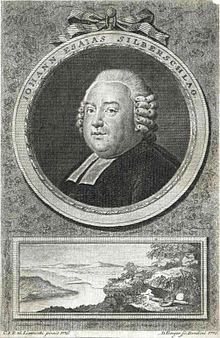Johann Esaia's silver strike

Johann Esaias Silberschlag (born November 16, 1721 in Aschersleben , † November 22, 1791 in Berlin ) was a German Lutheran theologian and naturalist .
He became known as a hydraulic engineer and school reformer. His name is particularly associated with the introduction of secondary school teaching. His half-brother was the natural scientist Georg Christoph Silberschlag .
Life
In 1745 he became a teacher in the Berge monastery near Magdeburg until he became a preacher in Wolmirsleben in 1753 . From 1756 to 1766 he was pastor at the Heiligegeistkirche in Magdeburg. In 1760 he was appointed a foreign member of the Royal Prussian Academy of Sciences , and in 1786 he became a full member. In 1766 he built a water art on the Fürstenwall in Magdeburg.
On June 25, 1769, he delivered an expert opinion to King Friedrich II of Prussia on the proposal to set up a wind machine in the Burgörner district in order to lift the penetrating pit water. He came to the conclusion that when there was no wind there was nothing else to do but to fall back on a steam engine , as it was already used in England, Sweden or Hungary. As a result, a steam engine designed by James Watt was first used on Prussian soil in the Burgörner district .
In 1769 he became director of the secondary school in Berlin. In 1770 he was appointed Secret Building Councilor (1787 Secret Building Councilor) for the newly established Upper Construction Department, Department of Mechanical Engineering and Hydraulic Engineering. In 1780 he observed the Brocken Specter apparition . In 1788 he prepared an expert opinion for the regulation of the Elbe near Magdeburg.
Silberschlag took the view that there was no real contradiction between theology and natural science, and championed this opinion in his geogeny or explanation of the Mosaic creation of the earth according to physical and mathematical principles .
The moon crater Silberschlag was named after him. The city of Magdeburg named a street in his honor as Silberschlagstraße .
literature
- Paul Tschackert : Silberschlag, Johann Esaias . In: Allgemeine Deutsche Biographie (ADB). Volume 34, Duncker & Humblot, Leipzig 1892, pp. 314-316.
- Martin Wiehle : Magdeburg personalities. Published by the Magistrate of the City of Magdeburg, Department of Culture. imPuls Verlag, Magdeburg 1993, ISBN 3-910146-06-6 .
- Lutz Koch : The Mosaic Earth Creation, the Brocken Ghost and the Klutert Cave. Works by Johann Esaias Silberschlag in Schwelmer libraries. In: Contributions to the local history of the city of Schwelm and its surroundings. New Series, Vol. 55 (2006), pp. 11-30 ( online ).
- Karl-Eugen Kurrer : The History of the Theory of Structures. Searching for Equilibrium , Ernst & Sohn 2018, p. 217 and p. 1062 (biography), ISBN 978-3-433-03229-9 .
Web links
- Works by and about Johann Esaias Silberschlag in the German Digital Library
- Website of the Deutsches Museum in Munich, short biography of Johann Esaias Silberschlag with an appreciation of his work
- Johann Esaias Silberschlag (1721-1791) - Practices and potentials of structural engineering history (Momentum Magazin)
Notes and individual evidence
- ↑ ADB and Deutsches Museum give 1716 as the year of birth
- ^ Members of the previous academies. Johann Esaia's silver strike. Berlin-Brandenburg Academy of Sciences and Humanities , accessed on June 17, 2015 .
| personal data | |
|---|---|
| SURNAME | Silberschlag, Johann Esaias |
| BRIEF DESCRIPTION | German Lutheran clergyman and natural scientist |
| DATE OF BIRTH | November 16, 1721 |
| PLACE OF BIRTH | Aschersleben |
| DATE OF DEATH | November 22, 1791 |
| Place of death | Berlin |
